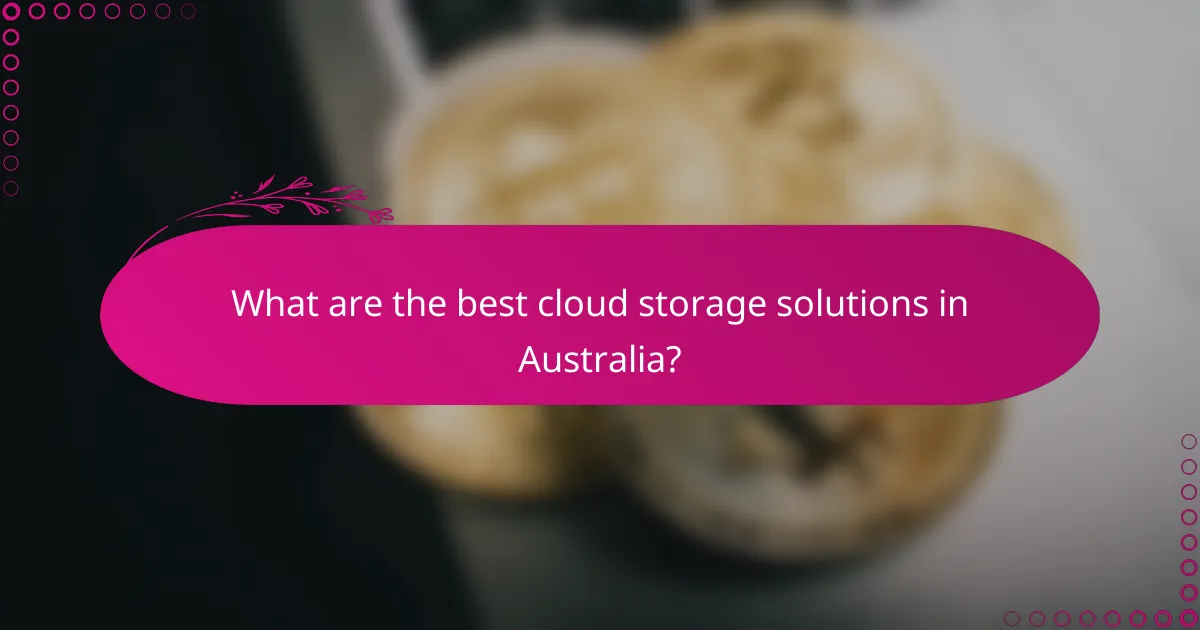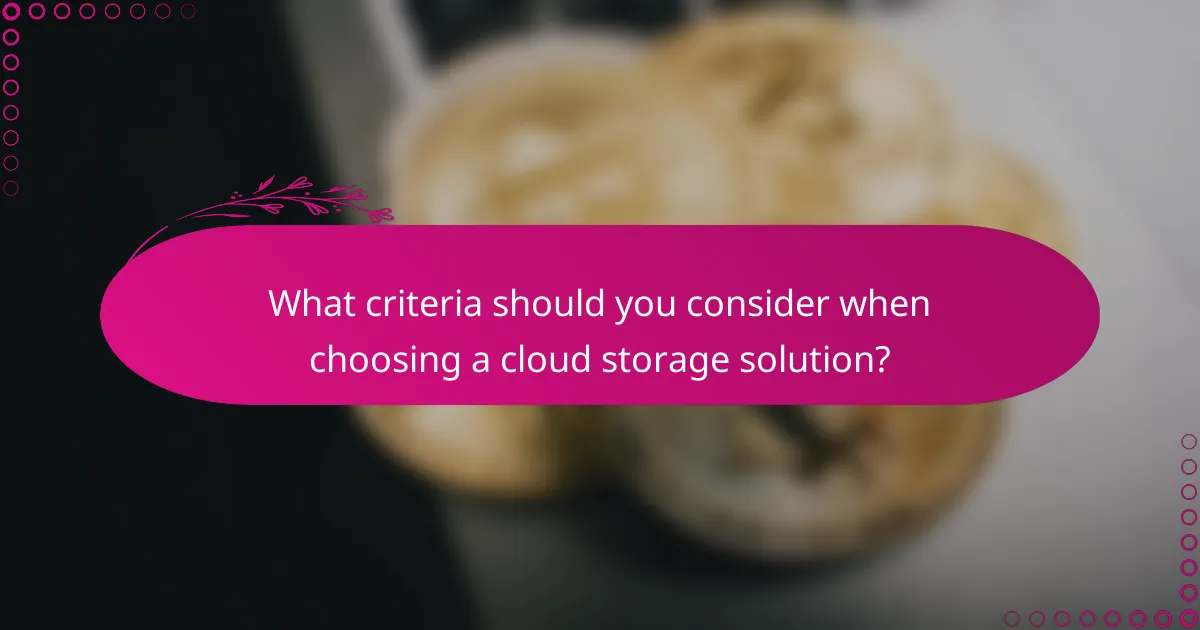Cloud storage solutions provide a secure and flexible way to manage data, offering features such as advanced encryption and access controls to protect sensitive information. With the ability to access files from anywhere, these services enhance productivity and collaboration for both personal and business use. Additionally, robust disaster recovery options ensure that data remains safe and recoverable in the event of unforeseen incidents.

What are the best cloud storage solutions in Australia?
In Australia, the best cloud storage solutions include popular options like Google Drive, Dropbox, Microsoft OneDrive, Box, and Amazon S3. These services offer varying features such as data security, remote access, and disaster recovery, catering to both personal and business needs.
Google Drive
Google Drive is a widely used cloud storage solution that integrates seamlessly with other Google services. It offers 15 GB of free storage, with options to purchase additional space through Google One.
Key features include real-time collaboration on documents, strong security measures, and easy sharing options. However, users should be aware of privacy concerns related to data scanning for ad targeting.
Dropbox
Dropbox is known for its user-friendly interface and efficient file synchronization across devices. It starts with 2 GB of free storage, with paid plans offering more space and advanced features.
It excels in file sharing and collaboration, making it ideal for teams. Users should consider its limitations on file size for uploads and the potential costs for additional storage.
Microsoft OneDrive
Microsoft OneDrive is integrated with Microsoft 365, making it a great option for users already in the Microsoft ecosystem. It provides 5 GB of free storage, with various subscription plans available for more space.
OneDrive offers strong security features, including personal vaults for sensitive files. Users should note that its performance can vary based on internet speed and the size of files being uploaded.
Box
Box is designed for businesses and offers robust security and compliance features, including HIPAA and GDPR support. It starts with 10 GB of free storage, with paid plans providing more advanced collaboration tools.
Box is particularly suitable for organizations that require strict data governance. However, its interface may feel less intuitive compared to other options, which could impact user experience.
Amazon S3
Amazon S3 (Simple Storage Service) is a scalable cloud storage solution primarily aimed at businesses and developers. It operates on a pay-as-you-go model, with costs based on storage used and data transfer.
S3 is known for its durability and security, making it ideal for backup and archiving. However, it requires technical knowledge to set up and manage effectively, which may not be suitable for all users.

How do cloud storage solutions enhance data security?
Cloud storage solutions enhance data security by implementing advanced technologies and practices that protect sensitive information from unauthorized access and data breaches. Key features include encryption, access controls, and compliance with various regulations that govern data protection.
Encryption methods
Encryption methods are crucial for securing data stored in the cloud. They convert data into a coded format that can only be accessed with a decryption key, ensuring that even if data is intercepted, it remains unreadable. Common encryption standards include AES-256, which is widely recognized for its strength and effectiveness.
When selecting a cloud storage provider, verify that they use strong encryption both during data transfer and at rest. This dual-layered approach significantly reduces the risk of data exposure.
Access controls
Access controls determine who can view or modify data within cloud storage systems. Implementing robust access control measures, such as role-based access and multi-factor authentication, helps ensure that only authorized users can access sensitive information. This minimizes the risk of insider threats and accidental data leaks.
Regularly review and update access permissions to reflect changes in personnel or project requirements. This practice helps maintain a secure environment and prevents unauthorized access over time.
Compliance with regulations
Compliance with regulations is essential for cloud storage solutions, especially for businesses handling sensitive data. Regulations such as GDPR in Europe and HIPAA in the United States set strict guidelines for data protection, requiring organizations to implement specific security measures.
Ensure that your cloud provider is compliant with relevant regulations for your industry. This not only protects your data but also helps avoid potential legal penalties and enhances your organization’s reputation for data security.

What are the benefits of remote access in cloud storage?
Remote access in cloud storage allows users to access their data from anywhere with an internet connection, enhancing flexibility and productivity. This capability is crucial for businesses and individuals who require seamless access to files and applications on various devices.
Accessibility from any device
Remote access enables users to retrieve and manage their data from a wide range of devices, including laptops, tablets, and smartphones. This versatility ensures that important files are always within reach, whether at home, in the office, or on the go.
To maximize accessibility, choose cloud storage solutions that offer mobile applications and web interfaces. This way, you can easily switch between devices without losing functionality or data integrity.
Collaboration features
Many cloud storage services come equipped with collaboration tools that facilitate teamwork, such as shared folders and real-time document editing. These features allow multiple users to work on the same file simultaneously, enhancing productivity and reducing the need for back-and-forth email exchanges.
When selecting a cloud storage provider, look for options that support user permissions and version control. This ensures that team members can collaborate effectively while maintaining data security and tracking changes.
Real-time updates
Remote access in cloud storage often includes real-time updates, meaning any changes made to documents are instantly saved and visible to all users. This feature minimizes confusion and ensures that everyone is working with the most current information.
To take advantage of real-time updates, choose a cloud storage solution that automatically syncs changes across devices. This will help prevent data loss and ensure that all collaborators are aligned on project progress.

How do cloud storage solutions support disaster recovery?
Cloud storage solutions enhance disaster recovery by providing automated backups, data redundancy, and geographic distribution. These features ensure that data remains accessible and secure even in the event of hardware failures, natural disasters, or cyberattacks.
Automated backups
Automated backups are a critical component of cloud storage disaster recovery. They enable regular, scheduled copies of data to be created without manual intervention, reducing the risk of human error. Users can typically set backup frequencies ranging from hourly to daily, ensuring that the most recent data is always available for recovery.
When choosing a cloud provider, look for options that allow you to customize backup settings and retain multiple versions of files. This flexibility can be vital in recovering from data corruption or accidental deletions.
Data redundancy
Data redundancy involves storing multiple copies of data across different locations or systems. This practice ensures that if one copy is lost or compromised, others remain intact and accessible. Most cloud storage providers implement redundancy by saving data across multiple servers and data centers.
When evaluating cloud solutions, check for redundancy protocols like RAID (Redundant Array of Independent Disks) and multi-region storage options. These features enhance data integrity and availability, which are essential for effective disaster recovery.
Geographic distribution
Geographic distribution refers to the practice of storing data in multiple locations around the world. This strategy protects against localized disasters, such as floods or earthquakes, by ensuring that data is not reliant on a single physical site. Cloud providers often have data centers in various regions to facilitate this distribution.
When selecting a cloud storage provider, consider their data center locations and the legal implications of data sovereignty. Some regulations may require that certain data be stored within specific jurisdictions, which can affect your disaster recovery strategy.

What criteria should you consider when choosing a cloud storage solution?
When selecting a cloud storage solution, consider factors such as data security, remote access capabilities, and disaster recovery options. These criteria will help ensure that your data is safe, accessible, and recoverable in case of an emergency.
Cost and pricing plans
Cost is a critical factor when evaluating cloud storage solutions. Pricing plans can vary significantly based on storage capacity, features, and the level of support offered. Look for options that fit your budget while providing the necessary functionality.
Many providers offer tiered pricing models, allowing you to pay for only what you need. For instance, basic plans may start at around $5 to $10 per month for a few hundred gigabytes, while larger businesses might require plans in the range of $50 to several hundred dollars monthly for terabytes of storage.
Be cautious of hidden fees, such as charges for data retrieval or exceeding storage limits. Always read the fine print and consider the total cost of ownership, including any potential upgrades or additional services you may need in the future.
